2007 CHEVROLET SILVERADO belt
[x] Cancel search: beltPage 604 of 684
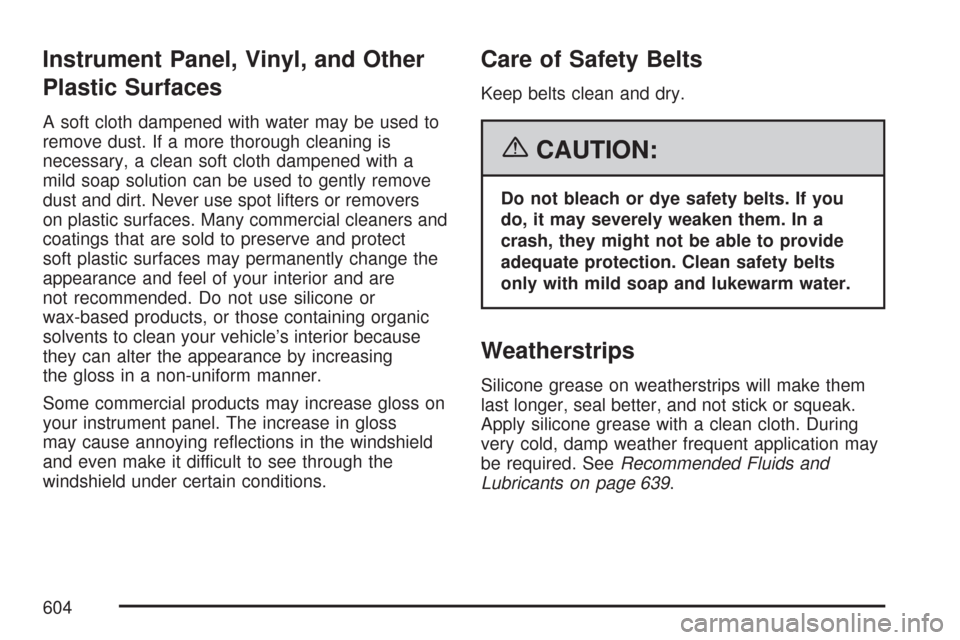
Instrument Panel, Vinyl, and Other
Plastic Surfaces
A soft cloth dampened with water may be used to
remove dust. If a more thorough cleaning is
necessary, a clean soft cloth dampened with a
mild soap solution can be used to gently remove
dust and dirt. Never use spot lifters or removers
on plastic surfaces. Many commercial cleaners and
coatings that are sold to preserve and protect
soft plastic surfaces may permanently change the
appearance and feel of your interior and are
not recommended. Do not use silicone or
wax-based products, or those containing organic
solvents to clean your vehicle’s interior because
they can alter the appearance by increasing
the gloss in a non-uniform manner.
Some commercial products may increase gloss on
your instrument panel. The increase in gloss
may cause annoying re�ections in the windshield
and even make it difficult to see through the
windshield under certain conditions.
Care of Safety Belts
Keep belts clean and dry.
{CAUTION:
Do not bleach or dye safety belts. If you
do, it may severely weaken them. In a
crash, they might not be able to provide
adequate protection. Clean safety belts
only with mild soap and lukewarm water.
Weatherstrips
Silicone grease on weatherstrips will make them
last longer, seal better, and not stick or squeak.
Apply silicone grease with a clean cloth. During
very cold, damp weather frequent application may
be required. SeeRecommended Fluids and
Lubricants on page 639.
604
Page 623 of 684

Maintenance Schedule................................ 624
Introduction............................................... 624
Maintenance Requirements........................ 624
Your Vehicle and the Environment............ 625
Using the Maintenance Schedule............... 625
Scheduled Maintenance
(Gasoline Engine).................................. 627
Additional Required Services
(Gasoline Engine).................................. 631
Maintenance Footnotes
(Gasoline Engine).................................. 633Owner Checks and Services..................... 635
At the First 100, 1,000 and 6,000 Miles
(160, 1 600 and 10 000 km).................. 635
At Each Fuel Fill....................................... 636
At Least Once a Month............................. 636
At Least Once a Year............................... 637
Recommended Fluids and Lubricants........ 639
Normal Maintenance Replacement Parts ... 642
Engine Drive Belt Routing......................... 643
Maintenance Record.................................. 644
Section 6 Maintenance Schedule
623
Page 632 of 684
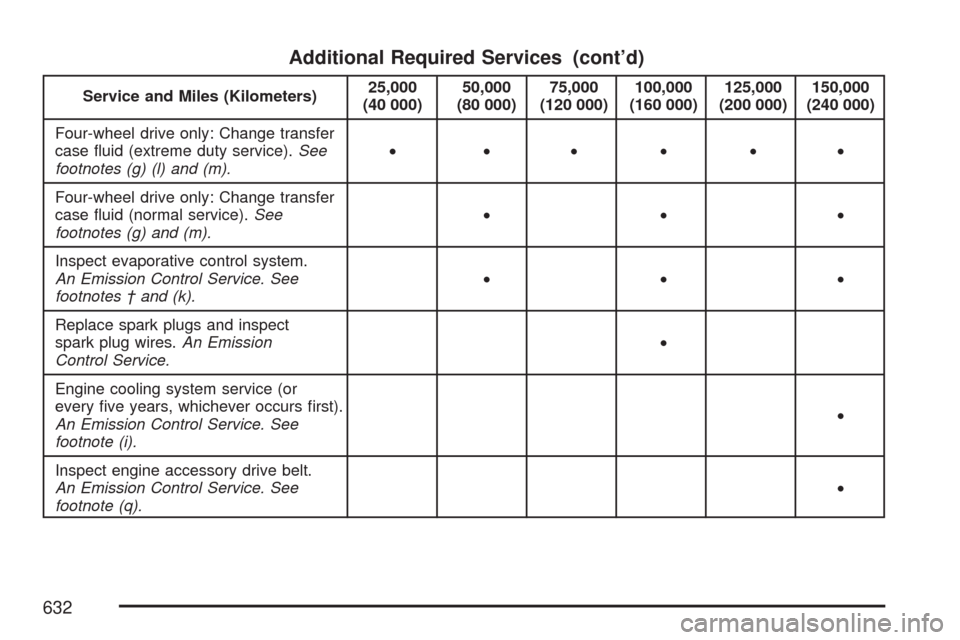
Additional Required Services (cont’d)
Service and Miles (Kilometers)25,000
(40 000)50,000
(80 000)75,000
(120 000)100,000
(160 000)125,000
(200 000)150,000
(240 000)
Four-wheel drive only: Change transfer
case �uid (extreme duty service).See
footnotes (g) (l) and (m).• •••••
Four-wheel drive only: Change transfer
case �uid (normal service).See
footnotes (g) and (m).•••
Inspect evaporative control system.
An Emission Control Service. See
footnotes † and (k).•••
Replace spark plugs and inspect
spark plug wires.An Emission
Control Service.•
Engine cooling system service (or
every �ve years, whichever occurs �rst).
An Emission Control Service. See
footnote (i).•
Inspect engine accessory drive belt.
An Emission Control Service. See
footnote (q).•
632
Page 634 of 684

(e)Make sure the safety belt reminder light and all
your belts, buckles, latch plates, retractors, and
anchorages are working properly. Look for
any other loose or damaged safety belt system
parts. If you see anything that might keep a safety
belt system from doing its job, have it repaired.
Have any torn or frayed safety belts replaced. Also
look for any opened or broken airbag coverings,
and have them repaired or replaced. The
airbag system does not need regular maintenance.
(f)Lubricate all key lock cylinders, body door
hinges, hood latch assembly, secondary latch,
pivots, spring anchor, release pawl, tailgate hinges,
tailgate linkage, tailgate handle pivot points,
latch bolt, fuel door hinge, locks, and folding seat
hardware. More frequent lubrication may be
required when exposed to a corrosive
environment. Applying silicone grease on
weatherstrips with a clean cloth will make them
last longer, seal better, and not stick or squeak.
(g)Check vent hose at transfer case for kinks and
proper installation. Check to be sure vent hose
is unobstructed, clear, and free of debris.(h)Change automatic transmission �uid and �lter
if the vehicle Gross Vehicle Weight Rating
(GVWR) is over 8600 lbs or if the vehicle is mainly
driven under one or more of these conditions:
�In heavy city traffic where the outside
temperature regularly reaches 90°F (32°C) or
higher.
�In hilly or mountainous terrain.
�When doing frequent trailer towing.
�Uses such as found in taxi, police or delivery
service.
(i)Drain, �ush, and re�ll cooling system. This
service can be complex; you should have
your dealer perform this service. See Engine
Coolant on page 514 for what to use. Inspect
hoses. Clean radiator, condenser, pressure cap,
and �ller neck. Pressure test the cooling
system and pressure cap.
(j)A �uid loss in any vehicle system could indicate
a problem. Have the system inspected and
repaired and the �uid level checked. Add �uid
if needed.
634
Page 635 of 684
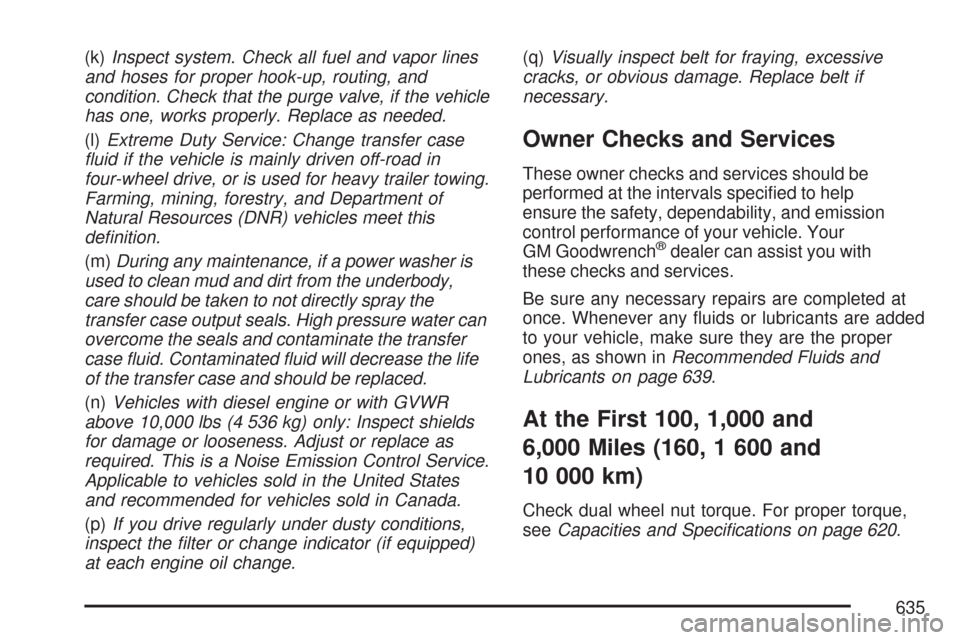
(k)Inspect system. Check all fuel and vapor lines
and hoses for proper hook-up, routing, and
condition. Check that the purge valve, if the vehicle
has one, works properly. Replace as needed.
(l)Extreme Duty Service: Change transfer case
�uid if the vehicle is mainly driven off-road in
four-wheel drive, or is used for heavy trailer towing.
Farming, mining, forestry, and Department of
Natural Resources (DNR) vehicles meet this
de�nition.
(m)During any maintenance, if a power washer is
used to clean mud and dirt from the underbody,
care should be taken to not directly spray the
transfer case output seals. High pressure water can
overcome the seals and contaminate the transfer
case �uid. Contaminated �uid will decrease the life
of the transfer case and should be replaced.
(n)Vehicles with diesel engine or with GVWR
above 10,000 lbs (4 536 kg) only: Inspect shields
for damage or looseness. Adjust or replace as
required. This is a Noise Emission Control Service.
Applicable to vehicles sold in the United States
and recommended for vehicles sold in Canada.
(p)If you drive regularly under dusty conditions,
inspect the �lter or change indicator (if equipped)
at each engine oil change.(q)Visually inspect belt for fraying, excessive
cracks, or obvious damage. Replace belt if
necessary.
Owner Checks and Services
These owner checks and services should be
performed at the intervals speci�ed to help
ensure the safety, dependability, and emission
control performance of your vehicle. Your
GM Goodwrench
®dealer can assist you with
these checks and services.
Be sure any necessary repairs are completed at
once. Whenever any �uids or lubricants are added
to your vehicle, make sure they are the proper
ones, as shown inRecommended Fluids and
Lubricants on page 639.
At the First 100, 1,000 and
6,000 Miles (160, 1 600 and
10 000 km)
Check dual wheel nut torque. For proper torque,
seeCapacities and Speci�cations on page 620.
635
Page 643 of 684

Engine Drive Belt Routing
(A) Air Conditioning CompressorV6 Engines
V8 Engines
643
Page 659 of 684
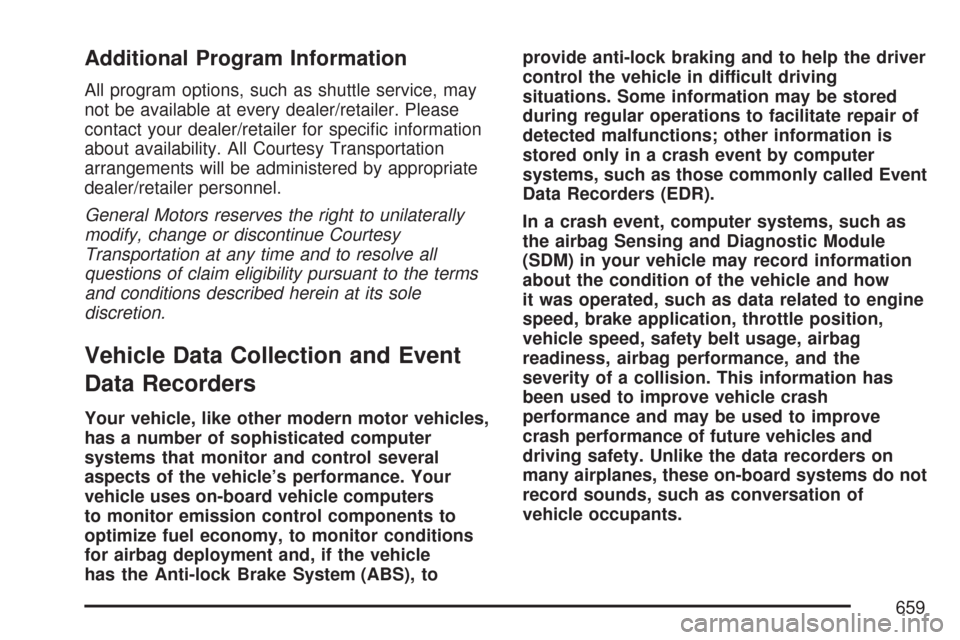
Additional Program Information
All program options, such as shuttle service, may
not be available at every dealer/retailer. Please
contact your dealer/retailer for speci�c information
about availability. All Courtesy Transportation
arrangements will be administered by appropriate
dealer/retailer personnel.
General Motors reserves the right to unilaterally
modify, change or discontinue Courtesy
Transportation at any time and to resolve all
questions of claim eligibility pursuant to the terms
and conditions described herein at its sole
discretion.
Vehicle Data Collection and Event
Data Recorders
Your vehicle, like other modern motor vehicles,
has a number of sophisticated computer
systems that monitor and control several
aspects of the vehicle’s performance. Your
vehicle uses on-board vehicle computers
to monitor emission control components to
optimize fuel economy, to monitor conditions
for airbag deployment and, if the vehicle
has the Anti-lock Brake System (ABS), toprovide anti-lock braking and to help the driver
control the vehicle in difficult driving
situations. Some information may be stored
during regular operations to facilitate repair of
detected malfunctions; other information is
stored only in a crash event by computer
systems, such as those commonly called Event
Data Recorders (EDR).
In a crash event, computer systems, such as
the airbag Sensing and Diagnostic Module
(SDM) in your vehicle may record information
about the condition of the vehicle and how
it was operated, such as data related to engine
speed, brake application, throttle position,
vehicle speed, safety belt usage, airbag
readiness, airbag performance, and the
severity of a collision. This information has
been used to improve vehicle crash
performance and may be used to improve
crash performance of future vehicles and
driving safety. Unlike the data recorders on
many airplanes, these on-board systems do not
record sounds, such as conversation of
vehicle occupants.
659
Page 669 of 684
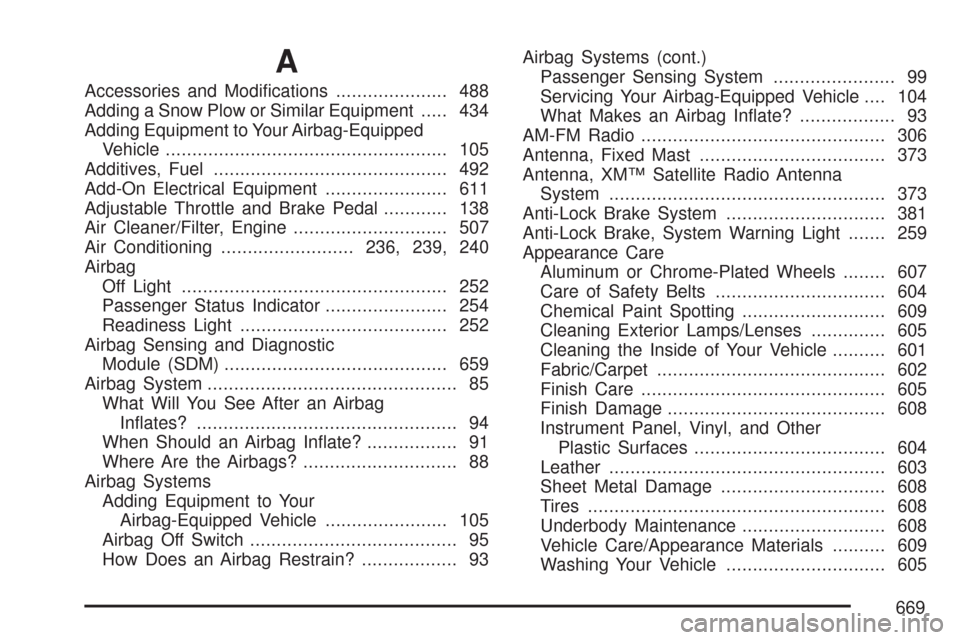
A
Accessories and Modi�cations..................... 488
Adding a Snow Plow or Similar Equipment..... 434
Adding Equipment to Your Airbag-Equipped
Vehicle..................................................... 105
Additives, Fuel............................................ 492
Add-On Electrical Equipment....................... 611
Adjustable Throttle and Brake Pedal............ 138
Air Cleaner/Filter, Engine............................. 507
Air Conditioning.........................236, 239, 240
Airbag
Off Light.................................................. 252
Passenger Status Indicator....................... 254
Readiness Light....................................... 252
Airbag Sensing and Diagnostic
Module (SDM).......................................... 659
Airbag System............................................... 85
What Will You See After an Airbag
In�ates?................................................. 94
When Should an Airbag In�ate?................. 91
Where Are the Airbags?............................. 88
Airbag Systems
Adding Equipment to Your
Airbag-Equipped Vehicle....................... 105
Airbag Off Switch....................................... 95
How Does an Airbag Restrain?.................. 93Airbag Systems (cont.)
Passenger Sensing System....................... 99
Servicing Your Airbag-Equipped Vehicle.... 104
What Makes an Airbag In�ate?.................. 93
AM-FM Radio.............................................. 306
Antenna, Fixed Mast................................... 373
Antenna, XM™ Satellite Radio Antenna
System.................................................... 373
Anti-Lock Brake System.............................. 381
Anti-Lock Brake, System Warning Light....... 259
Appearance Care
Aluminum or Chrome-Plated Wheels........ 607
Care of Safety Belts................................ 604
Chemical Paint Spotting........................... 609
Cleaning Exterior Lamps/Lenses.............. 605
Cleaning the Inside of Your Vehicle.......... 601
Fabric/Carpet........................................... 602
Finish Care.............................................. 605
Finish Damage......................................... 608
Instrument Panel, Vinyl, and Other
Plastic Surfaces.................................... 604
Leather.................................................... 603
Sheet Metal Damage............................... 608
Tires........................................................ 608
Underbody Maintenance........................... 608
Vehicle Care/Appearance Materials.......... 609
Washing Your Vehicle.............................. 605
669